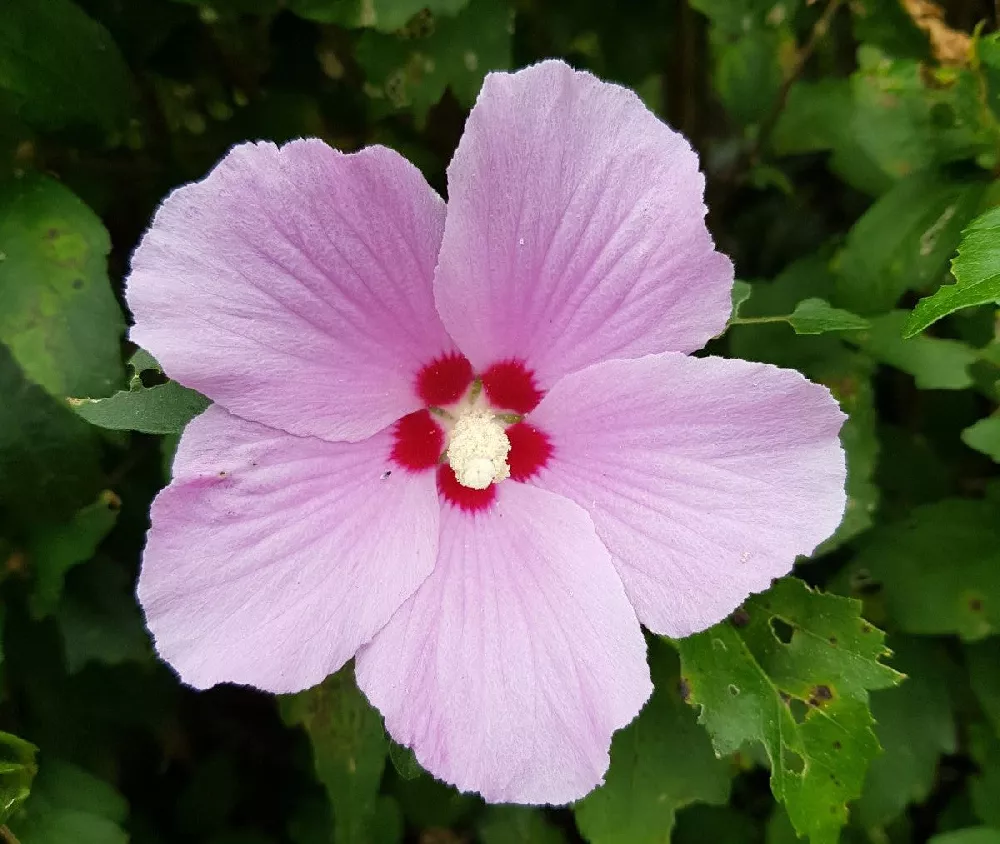- Home >
- Ornamental Plants >
- Aphrodite Rose of Sharon Althea Shrub
Aphrodite Rose of Sharon Althea Shrub for Sale - Buying & Growing Guide
Aphrodite Rose of Sharon Althea Shrub, Hibiscus syriacus 'Aphrodite,' is a large, vase-shaped cultivar that delights the senses with a summer-long display of large, vivid, pink blooms with deep red throats and prominent stamens. You'll get a good three months of bloom-time from this prolific bush, making it an excellent specimen plant for the front yard, where it can be easily seen by passers-by. It is also a lovely addition to shrub borders or foundation plantings, and is tall enough, at 6-10 feet, to make a good windscreen or privacy fence if planted in a row. Although it does not require extensive pruning, it can be shaped into a more formal hedge if desired. Here are a few more reasons to plant this versatile shrub:
- It is tolerant of urban pollution, making it a great choice for city gardens.
- It is fairly disease- and pest-free.
- Its bright flowers attract hummingbirds.
Enter your zip code to find nearby stores that may carry this plant.
Plant Care
Sunlight

Aphrodite Rose of Sharon grows best in partial to full sun — 4 or more hours of direct light a day.
Watering
Mature shrubs are drought-resistant; your shrub only needs water if it receives less than an inch of rain a week.
Fertilizing

Fertilize in early spring with a slow-release, general-purpose fertilizer designed for landscape trees and shrubs.
Planting and Care
Planting instructions
Site your Aphrodite where it will receive at least 4 hours of direct sun in soil that drains well. Unpot the shrub and tease out any encircling roots, which can girdle the tree and slowly kill it. Dig a hole that’s as deep as the root zone and twice as wide. Place the shrub in the hole, spreading out the roots. Holding the shrub upright and steady, fill in around the roots with topsoil, tamping down as you go to eliminate air pockets. Water thoroughly. Apply a 2- to 3-inch layer of organic mulch such as bark chips around the root zone to conserve moisture and hinder weed growth, but keep it from touching the trunk to avoid problems with rot.
Watering and nutrients
Your Aphrodite Rose of Sharon needs about an inch of water each week. If you have a week without rain, it will appreciate some supplemental watering. During very hot or dry weather, you might need to water more frequently. Fertilize your shrub with a balanced, slow-release fertilizer that is designed for landscape trees and shrubs. A 10-10-10 formula works well.
Pollination
Although the Aphrodite Rose of Sharon may attract hummingbirds and other pollinators with its vibrant flowers, it is a sterile cultivar, meaning that it does not set seed when the flowers are pollinated.
Pruning
Prune your shrub annually after it flowers or in late winter to promote new growth and shape it. Prune out dead, diseased, or damaged limbs whenever you see them.
Pests, diseases and animals
Rose of Sharon bushes are attractive to Japanese beetles, which can eat the leaves. There are traps available that can be used to deter them, however. Other common pests include nematodes and aphids. A healthy tree will be better able to resist infestation. Leaf spot and leaf rust are common diseases of the Rose of Sharon. Keep the area around your bush free of leaf debris, and trim out any branches that show signs of spots or lesions. Spraying with a copper fungicide in spring will also be helpful.
Achieving maximum results
One way to achieve maximum results with an Aphrodite shrub is to consider planting it in a large container, where it can serve as a patio plant or perhaps live as part of a matched set outside a formal front entrance. Gardeners who live in the far Northern regions of the U.S. may choose to grow it in a container and bring it into a garage or basement in the winter when the temperatures dip below -10 degrees Fahrenheit. Container growing is not difficult. Choose a pot for your shrub that is about twice the size of the root ball, with good drainage in the bottom. Use a good-quality potting mix, and plant your shrub as per our directions above. Keep in mind that container-grown plants may need more watering than those grown in the ground, so keep an eye on your Aphrodite and water it whenever the soil 2 inches below the surface is dry.
FAQs
How big does Aphrodite Rose of Sharon get?
When grown outside, this shrub will reach a mature height of 6-10 feet, with a width of 4-8 feet. If grown in a container, it may remain smaller because the roots are constricted by the pot in which they are growing. If you wish to control the height of your bush, careful pruning can keep it to the desired height.
Where can I grow Aphrodite shrub?
Your Aphrodite Rose of Sharon can handle temperatures down to -10 degrees Fahrenheit, which equates to USDA hardiness zones 5-9. That includes most of the continental U.S. except for the northern Midwest and New England. For gardeners in those regions, Aphrodite may be grown in a container that is brought to a sheltered area in winter.
How is Aphrodite Rose of Sharon best used in my landscape?
This shrub makes an excellent foundation planting with smaller perennial plants and shrubs in front of it. It can also be a fine specimen plant, especially when planted in multiples of three or five. It can serve as an attractive hedge or privacy screen, and its smaller size makes it a good choice for the urban garden.
Compare Similar Products
You can't add more Product Name - Product size to the cart.
OK








